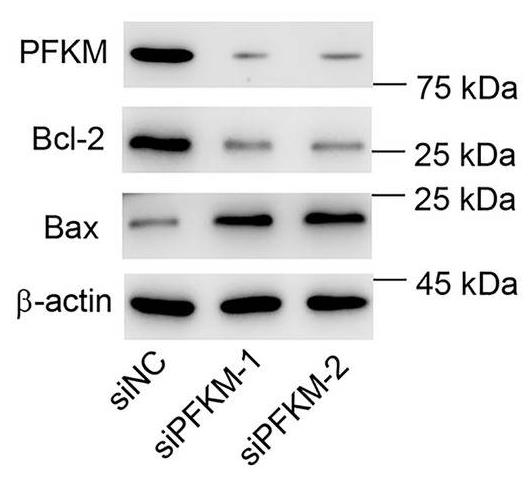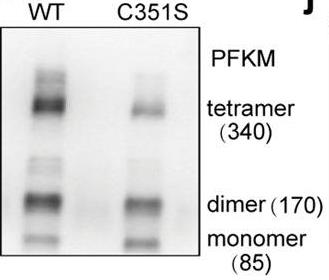PFKM
-
Official Full Name
Fructose-6-Phosphate Kinase -
Overview
Phosphofructokinase catalyzes the irreversible conversion of fructose 6 phosphate to fructose 1,6 bisphosphate. Mammalian PFK is a complex isozyme consisting of 3 subunits: muscle (M), liver (L), and platelet (P). Each subunit is encoded by a separate structural locus on chromosomes 1(M), 21(L), and 10(P). PFKL is the major form in liver and kidney while only M type PFK isozyme is expressed in mature muscle; therefore, muscle contains only homotetramers of M subunits. Erythrocytes contain both L and M subunits, and these randomly tetramerize to form M4, L4, and 3 additional hybrid forms of the holoenzyme. -
Synonyms
Fructose-6-Phosphate Kinase;6 Phosphofructokinase Muscle;EC 2.7.1.11;GSD7;MGC8699;PFKA;PFKL;PFKM;PFKP;PFKX;Phosphofructo 1 Kinase Isozyme A;Phosphofructokinase 1;Phosphofructokinase M;Phosphofructokinase muscle;Phosphofructokinase muscle type;Phosphofructokinase polypeptide X;Phosphohexokinase;6-phosphofructokinase;phosphofructokinase
Recombinant Proteins
- Mouse
- Human
- Rat
- Chicken
- Mammalian Cells
- E.coli
- Insect Cells
- HEK293
- His
- T7
- Non
- Avi
- Fc
- GST
- DDK
- Myc
- Flag
Background
What is PFKM Protein?
PFKM gene (phosphofructokinase, muscle) is a protein coding gene which situated on the long arm of chromosome 12 at locus 12q13. Three phosphofructokinase isozymes exist in humans: muscle, liver and platelet. These isozymes function as subunits of the mammalian tetramer phosphofructokinase, which catalyzes the phosphorylation of fructose-6-phosphate to fructose-1,6-bisphosphate. Tetramer composition varies depending on tissue type. This gene encodes the muscle-type isozyme. Mutations in this gene have been associated with glycogen storage disease type VII, also known as Tarui disease. The PFKM protein is consisted of 780 amino acids and PFKM molecular weight is approximately 85.2 kDa.
What is the Function of PFKM Protein?
PFKM is an enzyme expressed in muscle tissue, where it plays a key role in the process of glycolysis. Glycolysis is a metabolic pathway that breaks down glucose into lactic acid or into the energy-rich molecule ATP. The function of PFKM is to catalyze the phosphorylation of D-fructose 6-phosphate to produce fructose 1, 6-diphosphate, the first and limiting step of glycolysis. In one study, PFKM was found to inhibit doxorubicin-induced cardiotoxicity by enhancing oxidative phosphorylation and glycolysis. In addition, down-regulation of PFKM promoted apoptosis and inhibited oxidative phosphorylation and glycolysis. These findings suggest that PFKM may have a protective effect in heart disease, especially in the context of cardiotoxicity.
PFKM Related Signaling Pathway
The expression and activity of PFKM are regulated by a variety of factors, including its interaction with different signaling pathways. For example, PFKM is involved in the prevention and treatment of lung diseases such as pulmonary hypertension and sepsis by regulating the glycolytic pathway. In addition, PFKM is associated with the tumor suppressor p53, which can activate the expression of PFKM and in turn inhibit glycolysis, providing a potential new strategy for cancer treatment. PFKM activity is also regulated by a variety of cellular signaling events, including O-GlcNAcylation, pyruvate, P-tyrosine, phenylalanine, alanine, ATP, and the thyroid hormone T3. In the cell interior, PFKM not only plays a role as a key enzyme in the glycolytic pathway, but also participates in the regulation of gene expression in the nucleus by forming different configurations of tetramer and dimer, affecting tumor cell metabolism, epithelial-mesenchymal transformation (EMT), invasion and metastasis, and cell proliferation.
PFKM Related Diseases
Pfkm-associated diseases include glycogen storage disease type VII (Tarui disease) caused by mutations in the PFKM gene, a rare inherited metabolic disorder characterized by exercise intolerance, muscle spasm, myoglobinuria, and concomitant hemolytic anemia and hyperuricemia. The deficiency of PFKM leads to the obstruction of the glycolytic pathway and affects the normal energy metabolism of muscle cells. In addition, abnormal expression or dysfunction of PFKM has been implicated in the development of certain cancers, for example by influencing the Warburg effect (cancer cells tend to produce energy through glycolysis rather than oxidative phosphorylation even when oxygen is abundant) to promote tumor growth.

Fig1. Schematic illustration on the signaling pathway of NAT10 in glycolysis via targeting signaling axis for YTHDC1-LDHA/PFKM signaling axis. (Zhongting Mei, 2024)
Bioapplications of PFKM
PFKM has become a target for drug development and clinical therapeutic research due to its key role in the glycolytic pathway and its properties associated with a variety of diseases. At present, direct applications for PFKM are focused on the development of small molecule drugs that can regulate its activity to treat metabolic diseases such as glycogen storage disease type VII. In addition, PFKM's role in tumor metabolism makes it a potential target for cancer therapy, and it is being investigated to interfere with the metabolic pathways of tumor cells by targeting PFKM, thereby inhibiting tumor growth and metastasis.
Case Study
Case Study 1: Min Zhou, 2022
Heart failure (HF) is a global pandemic which affects about 26 million people. PFKM (Phosphofructokinase, Muscle), catalyzing the phosphorylation of fructose-6-phosphate, plays a very important role in cardiovascular diseases. However, the effect of PFKM in glycolysis and HF remains to be elucidated. H9c2 rat cardiomyocyte cells were treated with doxorubicin (DOX) to establish injury models, and the cell viability, apoptosis and glycolysis were measured. Quantitative reverse transcription-polymerase chain reaction (RT-PCR) and immunoblotting were used for gene expression. DOX treatment significantly inhibited PFKM expression in H9c2 cells. Overexpression of PFKM inhibited DOX-induced cell apoptosis and DOX-decreased glycolysis and oxidative phosphorylation (OXPHOS), while silencing PFKM promoted cell apoptosis and inhibited glycolysis and OXPHOS in H9c2 cells. Moreover, PFKM regulated DOX-mediated cell viability and apoptosis through glycolysis pathway. Mechanism study showed that histone deacetylase 1 (HDAC1) inhibited H3K27ac-induced transcription of PFKM in DOX-treated cells and regulated glycolysis. PFKM could inhibit DOX-induced cardiotoxicity by enhancing OXPHOS and glycolysis, which might benefit us in developing novel therapeutics for prevention or treatment of HF.

Fig1. Expression of PFKM, Bcl-2 and Bax.

Fig2. ChIP assay of H3K27ac on the PFKM promoter.
Case Study 2: Wenwen Gao, 2021
One of the malignant transformation hallmarks is metabolism reprogramming, which plays a critical role in the biosynthetic needs of unchecked proliferation, abrogating cell death programs, and immunologic escape. However, the mechanism of the metabolic switch is not fully understood. Here, the S-nitrosoproteomic profile of endogenous nitrogen oxide in ovarian cancer cells targeted multiple components in metabolism processes. Phosphofructokinase (PFKM), one of the most important regulatory enzymes of glycolysis, was S-nitrosylated by nitric oxide synthase NOS1 at Cys351. S-nitrosylation at Cys351 stabilized the tetramer of PFKM, leading to resist negative feedback of downstream metabolic intermediates. The PFKM-C351S mutation decreased the proliferation rate of cultured cancer cells, and reduced tumor growth and metastasis in the mouse xenograft model.

Fig3. Co-IP detected whether NOS1 with PFKL, PFKP, and PFKM could bind in SKOV3-OE-NOS1 cells by using NOS1 monoclonal antibody.

Fig4. Western blot detected the contents of PFKM tetramer, dimer, and monomer.
Quality Guarantee
High Purity
.jpg)
Fig1. SDS-PAGE (PFKM-2582H)
.
.jpg)
Fig2. SDS-PAGE (PFKM-473HFL)
Involved Pathway
PFKM involved in several pathways and played different roles in them. We selected most pathways PFKM participated on our site, such as Glycolysis / Gluconeogenesis,Pentose phosphate pathway,Fructose and mannose metabolism, which may be useful for your reference. Also, other proteins which involved in the same pathway with PFKM were listed below. Creative BioMart supplied nearly all the proteins listed, you can search them on our site.
| Pathway Name | Pathway Related Protein |
|---|---|
| Metabolic pathways | SI,PCCB,MTMR6,BDH1,AKR1B1L,FOLH1,HYAL2,ALG14,ATP5E,GMDS |
| Glycolysis / Gluconeogenesis | ADH1C,ENO1B,LDHBA,PKMA,ALDH3A1,AKR1A1B,PDHA1,ALDOAB,ALDOA,PDHA2 |
| Fructose and mannose metabolism | TIGARA,PFKL,PMM1,PFKFB1,PFKMA,GMPPB,GMPPAA,ALDOB,FPGT,Akr1b3 |
| Carbon metabolism | SDHA,PRPS1B,GPI,PCXB,PGAM1B,ESD,DLAT,PKM,CAT,FBP2 |
| Galactose metabolism | UGP2A,HK2,GALE,G6PC3,GALK1,UGP2B,GALT,SI,LALBA,PFKL |
| Central carbon metabolism in cancer | MAP2K2,MAP2K1,MAPK1,G6PD,RAF1,PDHA1,SLC2A2,G6PDX,PIK3CA,RET |
| Biosynthesis of amino acids | TPI1,IDH2,CBS,MAT1A,MAT2AL,ARG1,GPT2,GOT1,SHMT1,GLUL |
| AMPK signaling pathway | CREB3L2,PPP2R5B,CCNA2,AKT3,ADIPOR2,RAB14,PPP2CB,EEF2,INS2,PPP2R2C |
| RNA degradation | BTG3,PAPD7,CNOT6L,EXOSC9,EXOSC6,PFKMB,EXOSC3,LSM5,GM5506,TOB2 |
Protein Function
PFKM has several biochemical functions, for example, 6-phosphofructokinase activity,ATP binding,fructose binding. Some of the functions are cooperated with other proteins, some of the functions could acted by PFKM itself. We selected most functions PFKM had, and list some proteins which have the same functions with PFKM. You can find most of the proteins on our site.
| Function | Related Protein |
|---|---|
| metal ion binding | MYO9B,ZBED1,NT5DC1,ARMC1,ZNF576.2,ITGA2,PTGS2,KLF7A,ZNRF2B,HBB-B2 |
| kinase binding | UBQLN1,SGOL1,GFAP,MOBKL1A,SP100,CHIA,LDHA,CDC6,C2orf44,DLG1 |
| protein C-terminus binding | PCGF1,DAB2,PDZD3,VTA1,BAIAP2,SNTG1,BLOC1S2A,ERCC6,ARL6IP5,ATP1B1 |
| 6-phosphofructokinase activity | PFKLB,PFKL,PFKMB,PFKMA,PFKP |
| fructose binding | PFKL,ALDOA,ALDOB |
| protein binding | MID1,MAD2L2,CHID1,SLC35F6,GFAP,ZBTB16,FAM54B,COL10A1,SH3PXD2B,DNASE1 |
| protein homodimerization activity | TRIM5,HSD17B4,GJC3,APOA2,CAT,HAND1,ACTN4,YARS2,SQSTM1,TFAP4 |
| identical protein binding | KCTD17,CLPP,RAD51,SERPINA1D,DRG1,CTSC,COIL,HNRNPC,G6PD,DIAP1 |
| ATP binding | ABCD3A,RAD17,STK30,MAPK7,MYO7B,CHST13,CHEK2,GK2,DARS2,CSNK1G2A |
Interacting Protein
PFKM has direct interactions with proteins and molecules. Those interactions were detected by several methods such as yeast two hybrid, co-IP, pull-down and so on. We selected proteins and molecules interacted with PFKM here. Most of them are supplied by our site. Hope this information will be useful for your research of PFKM.
PFKL;SIAH1;1-phosphatidyl-1d-myo-inositol 4,5-bisphosphate;MCC;NDUFB2;Hoxa1;MAPK3;PDGFRL;SFRP4
Resources
Related Services
Related Products
References


